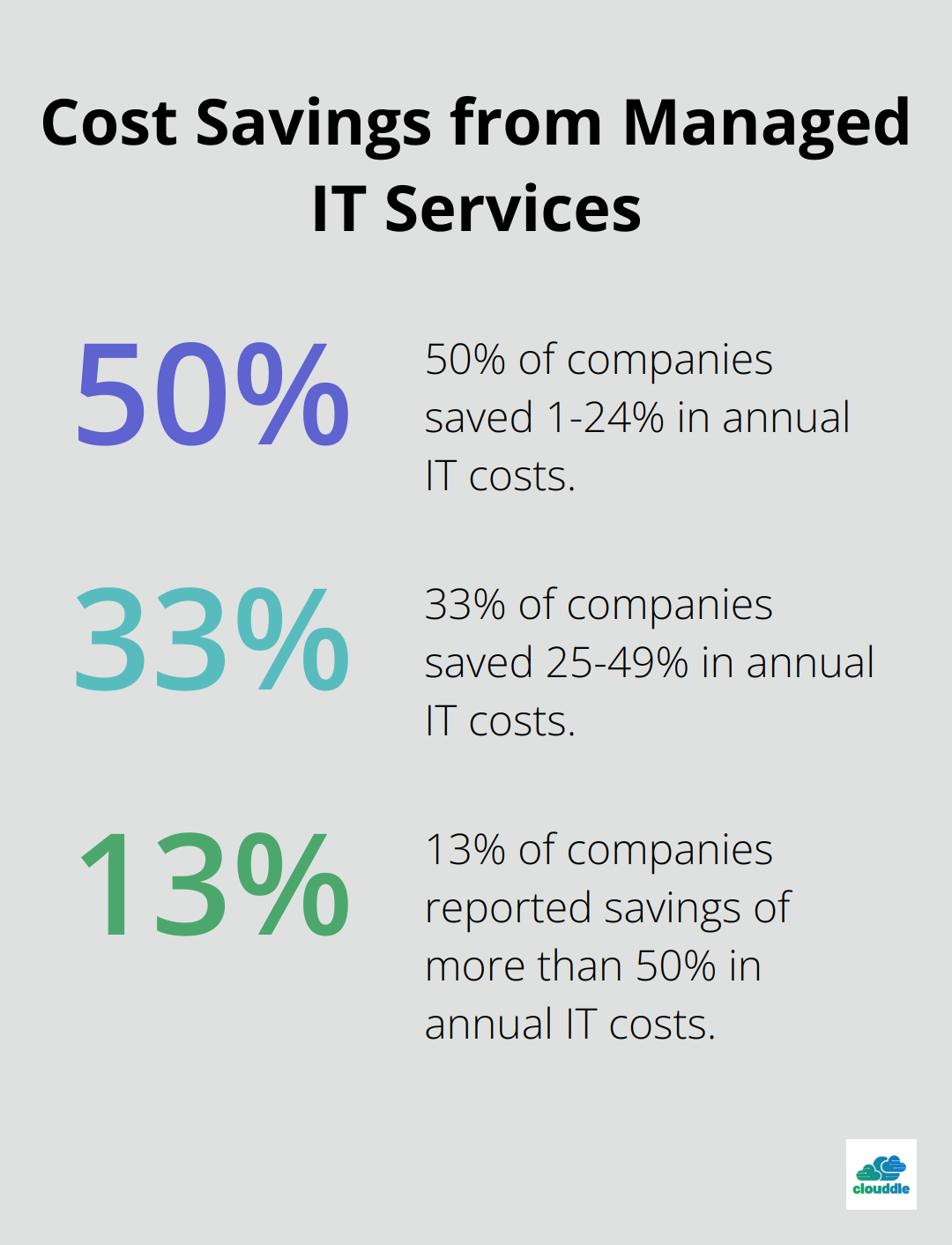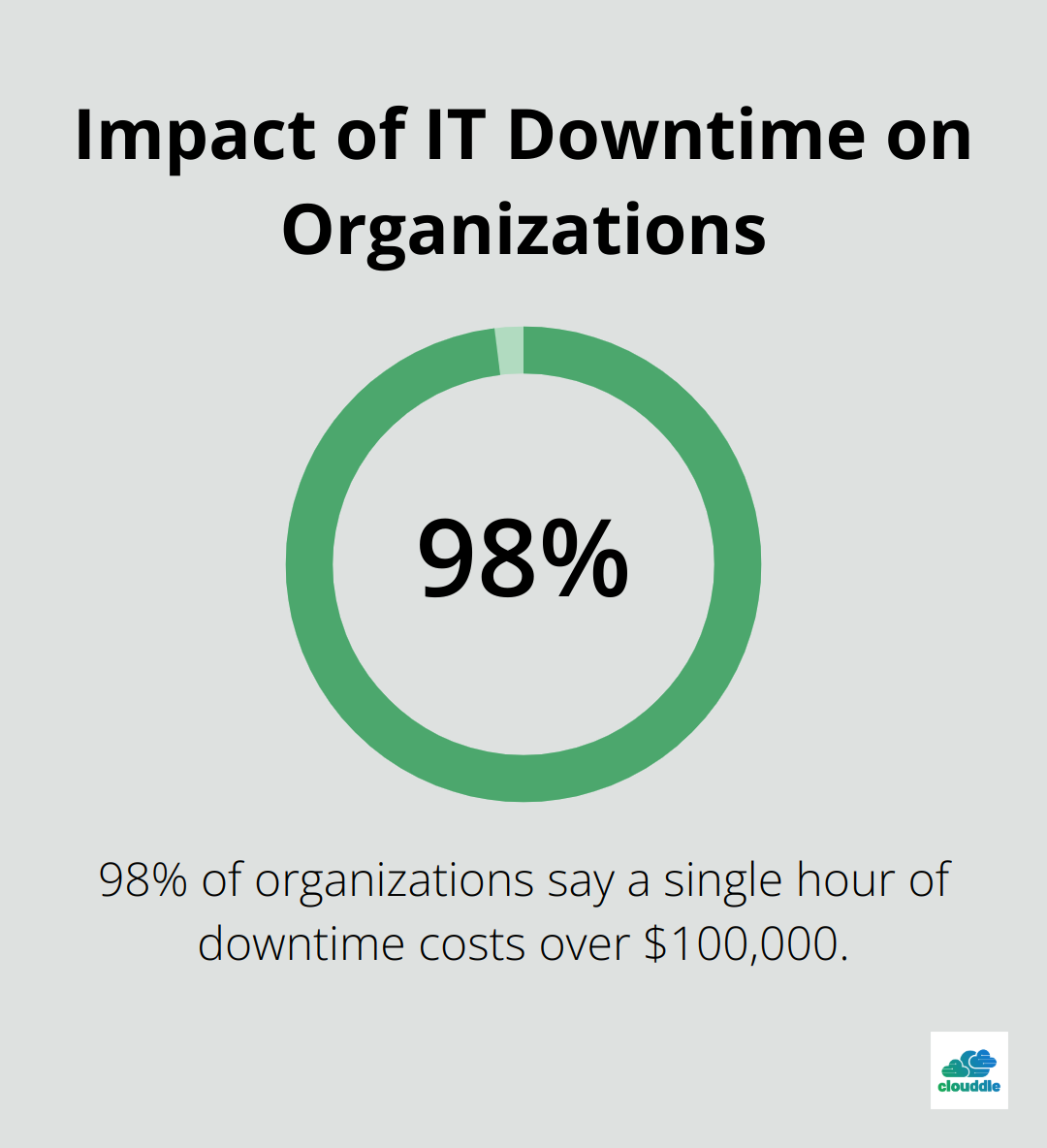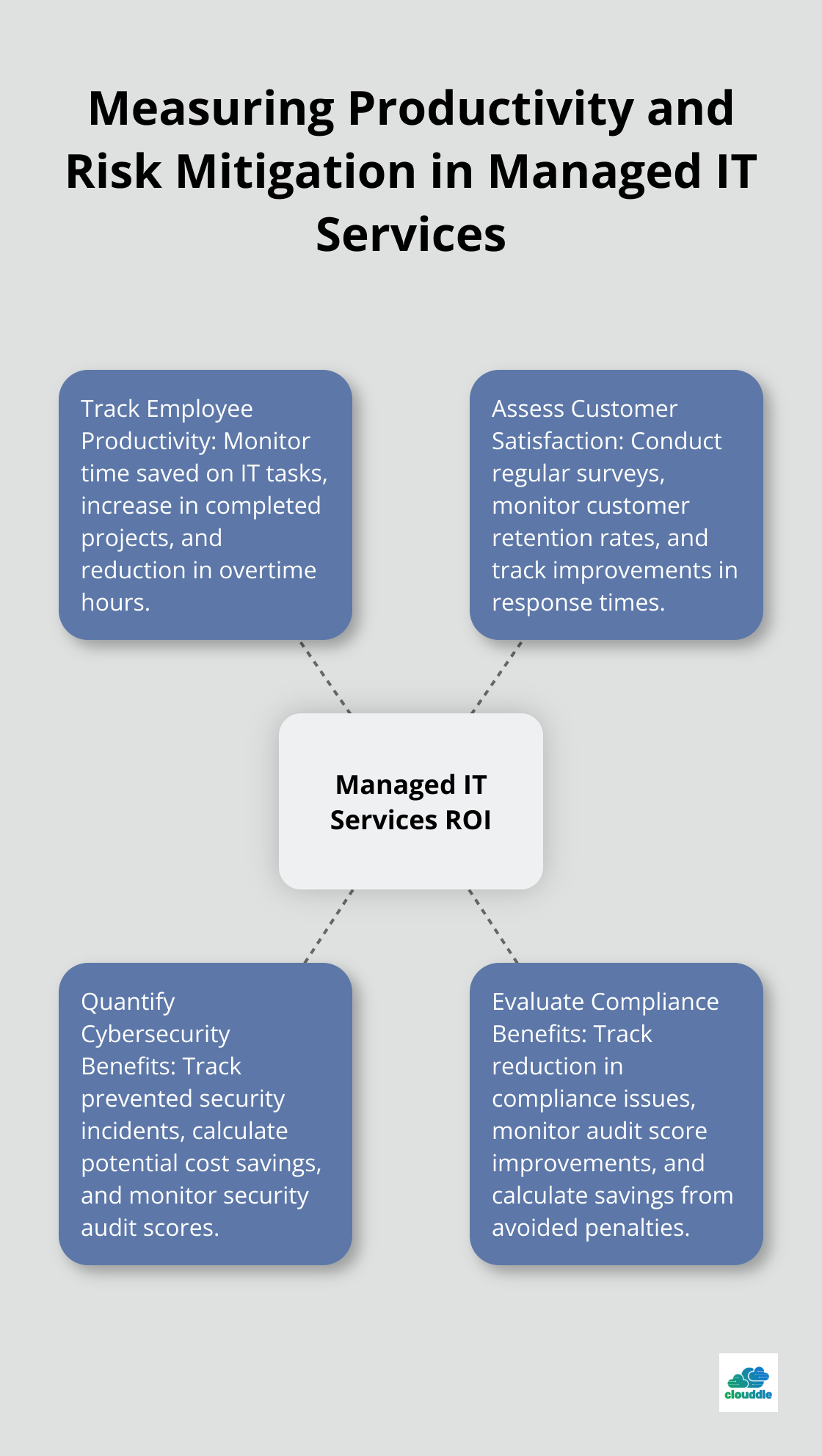Calculating the return on investment (ROI) for managed IT services can be challenging. Many businesses struggle to quantify the full value these services bring to their operations.
At Clouddle, we’ve developed a Managed IT Services ROI Calculator to help organizations assess the financial impact of their IT investments. This tool considers direct cost savings, productivity gains, and risk mitigation factors.
In this post, we’ll break down the key components of ROI for managed IT services and show you how to measure them effectively.
What Drives ROI in Managed IT Services?
Direct Cost Savings: The Immediate Impact
Direct cost savings represent the most visible and quantifiable benefit of managed IT services. These savings stem from reduced hardware and software expenses, lower IT staffing costs, and decreased training expenditures. A survey by CompTIA reveals that 50% of companies engaging an MSP saved 1-24% in annual IT costs, 33% saved 25-49%, and 13% reported savings of more than 50%. Implementing effective IT cost saving strategies can significantly boost these savings.

Indirect Cost Savings: The Hidden Value
Indirect cost savings, though less obvious, hold equal importance. These include reduced downtime, improved operational efficiency, and better resource allocation. According to Gartner, the average cost of IT downtime is $5,600 per minute. Managed IT services minimize downtime, which leads to substantial savings. Companies can also redirect internal resources to core business functions, further enhancing overall efficiency.
Productivity Gains: Empowering Your Workforce
Productivity gains significantly drive ROI in managed IT services. Reliable IT infrastructure and support allow employees to focus on their primary responsibilities without tech-related interruptions. An IDC survey found that organizations using managed services increased their technology adoption rate by 40%, which improved productivity across various business functions. Co-managed IT support can further enhance these productivity gains by combining internal expertise with external resources.
Risk Mitigation: Protecting Your Business
Risk mitigation (often overlooked) forms a key component of ROI in managed IT services. Robust security measures and compliance with industry regulations help businesses avoid costly data breaches and regulatory fines. IBM’s Cost of a Data Breach Report states that the average cost of a data breach in 2021 was $4.24 million. Managed IT services play a vital role in preventing such incidents, thus protecting a company’s bottom line and reputation.
Now that we understand the key drivers of ROI in managed IT services, let’s explore how to calculate direct and indirect cost savings in more detail.
How to Quantify Cost Savings from Managed IT Services
Calculating the direct and indirect cost savings from managed IT services is essential for understanding their true value. Let’s explore the key areas where businesses can expect to see financial benefits.
Hardware and Software Cost Reduction
Managed IT services can significantly reduce hardware and software costs. Many managed service providers (MSPs) offer cloud-based solutions, which eliminate the need for expensive on-premise hardware. Software licensing costs can also decrease substantially. MSPs often have partnerships with software vendors, allowing them to offer better pricing. They can also help optimize software usage, ensuring companies don’t overpay for unused licenses.
IT Staffing and Training Savings
The cost of hiring and training in-house IT staff can be substantial. The Society for Human Resource Management reports that the average cost-per-hire is $4,129, and it takes about 42 days to fill a position. Managed IT services can significantly reduce these costs.
A retail chain reallocated 60% of their IT budget from staffing to strategic initiatives by outsourcing their IT management. This not only saved money but also allowed them to focus on core business activities.
Downtime Reduction Impact
Downtime can be incredibly costly. A study found that 98% of organizations say a single hour of downtime costs over $100,000. Managed IT services can dramatically reduce downtime through proactive monitoring and rapid response times.

Operational Efficiency Gains
Improved operational efficiency often gets overlooked when calculating ROI, but it can have a significant impact. Managed IT services streamline processes, automate routine tasks, and provide better tools for collaboration and productivity.
A logistics company saw a 20% increase in overall productivity after implementing managed IT solutions. This translated to an annual saving of $300,000 in operational costs.
To accurately calculate these savings, it’s important to establish baseline metrics before implementing managed IT services. Track key performance indicators (KPIs) such as IT-related downtime, help desk response times, and employee productivity. Compare these metrics before and after implementation to quantify the improvements.
While some benefits appear immediately, others take time to materialize. Regular inspections of your managed IT services’ performance will help you understand their long-term value and ROI.
Now that we’ve examined the cost savings, let’s turn our attention to how managed IT services can boost productivity and mitigate risks for your business.
How to Measure Productivity and Risk Mitigation in Managed IT Services
Measuring productivity gains and risk mitigation is essential for understanding the full value of managed IT services. Let’s explore practical ways to quantify these benefits.

Track Employee Productivity
One of the most tangible ways to measure productivity gains is through employee output metrics. To measure this in your organization:
- Establish baseline productivity metrics before implementing managed IT services
- Monitor these metrics over time
- Focus on key areas such as:
- Time saved on IT-related tasks
- Increase in completed projects or tasks
- Reduction in overtime hours due to IT issues
Managed IT services can provide significant value by reducing overhead expenses associated with maintaining an in-house IT team, such as benefits and office space.
Assess Customer Satisfaction Impact
Improved IT infrastructure often leads to better customer experiences. To measure this in your business:
- Conduct regular customer satisfaction surveys
- Monitor changes in customer retention rates
- Track improvements in response times to customer inquiries
Quantify Cybersecurity Benefits
Cybersecurity incident prevention is a critical aspect of managed IT services. To measure this:
- Track the number of prevented security incidents
- Calculate the potential cost savings from avoided breaches
- Monitor improvements in security audit scores
Evaluate Compliance Benefits
Compliance with industry regulations is another area where managed IT services can provide significant value. To measure compliance benefits:
- Track reduction in compliance-related issues
- Monitor improvements in audit scores
- Calculate savings from avoided non-compliance penalties
By implementing robust network security measures and continuously monitoring network performance, organizations can significantly enhance their productivity and mitigate risks associated with IT infrastructure.
Final Thoughts
Calculating ROI for managed IT services requires a comprehensive approach. Direct cost savings, indirect benefits, productivity gains, and risk mitigation all contribute to the overall value. Regular assessment ensures these services continue to align with organizational goals as technology and business needs evolve.
Managed IT services provide a foundation for scalable growth, enhanced security, and improved operational efficiency. These services enable businesses to focus on core competencies while staying ahead of technological advancements. Our Managed IT Services ROI Calculator helps quantify the value of IT investments (considering factors such as cost savings and risk reduction).
Clouddle offers managed IT services that can transform technology from a cost center into a strategic asset. We provide seamless networking solutions and robust security measures to support long-term success in the digital world. Try our ROI calculator to evaluate your IT needs and make data-driven decisions about your technology investments.


